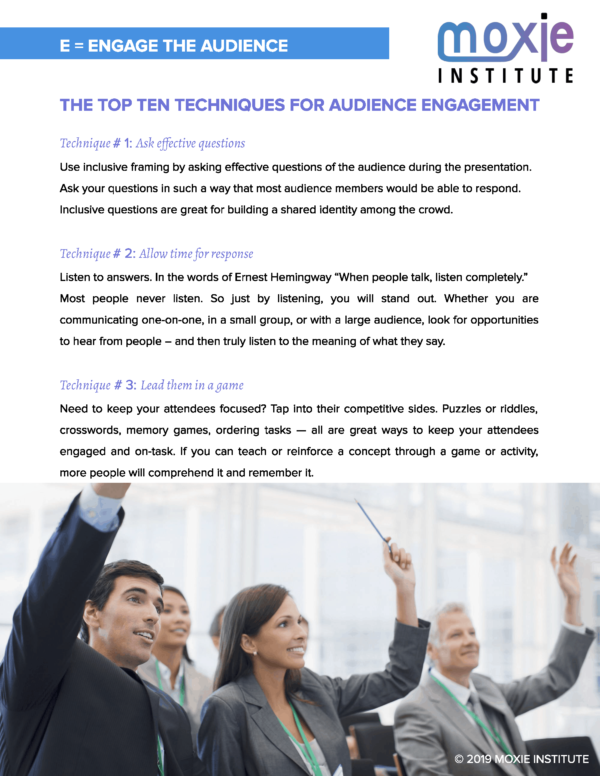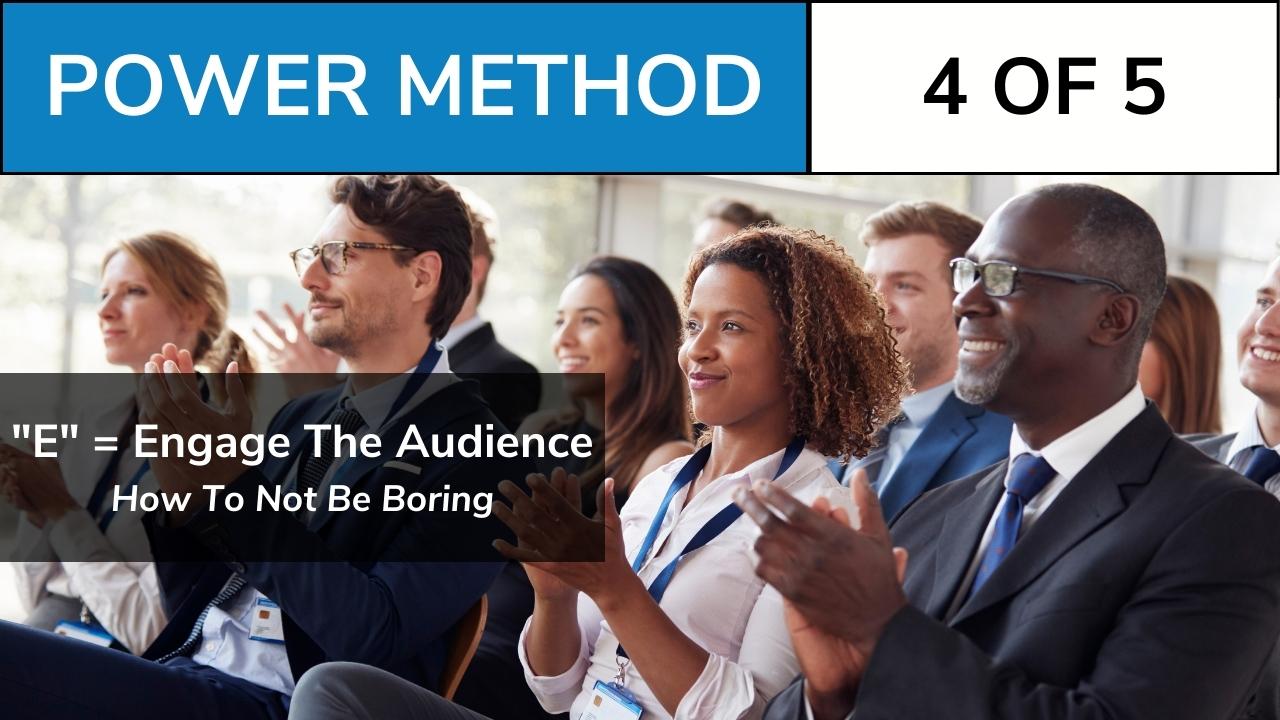Welcome back to our five-part series on how to write a speech!
Can you believe that we’re almost to the end of our speechwriting journey. Just two letters left! This article covers the “E” of our POWER method, Audience Engagement. In this blog we’ll be focusing on how to engage with your audience. We’ll be sharing tips like:
- Paying for actors in the audience
- Spraying distracted people with a water gun
Just kidding, we’ll actually be harnessing the power of audience engagement through tips like:
- The “10-Minute Rule”
- Emotionally Competent Stimulus
- Asking Questions
- And more!
With a variety of audience engagement techniques available, you’ll want to refer back to your audience analysis from Part 1 to determine the best ones for your situation..
We’ve already covered that “winging it” doesn’t work when you’re presenting a speech.
It’s crucial that you plan ahead and choose a technique that fits your objective and the allotted time for your presentation.
Audience participation encompasses a broad range of activities from a simple show of hands, to requests for personal input, role-playing, and games.
Each of these techniques has its merits. So before asking for audience participation, think about the types of responses you’d like to get.
With so many techniques to choose from it may feel overwhelming, don’t worry if writing isn’t your cup of tea, we can always help you with our custom speech writing services too.
But for today, we’ll break down some of our top techniques for audience engagement for both speechwriting and presenting purposes.
Table of Contents
ToggleHOW TO PLAN AUDIENCE ENGAGEMENT
You want audience input to be meaningful and to help you make a point.
Be clear about your purpose and consider how audience engagement techniques will help build your case.
Most importantly, think about what you’ll say if you don’t get the responses you expect. Better to be prepared for the rogue audience member that is a contrarian and looking to debate anything and will take any stance in order to disagree with you.
Anticipation is key in all things, speechwriting is no exception.
Audience participation should add value to your talk.
So keep in mind that if the participation could cause confusion, too much stimuli, or a loss of control over the room, you’re heading down the wrong path.
It’s important to plan where in your speech you’ll be using audience engagement too.
Variety is the spice of life and your speech should be thought of in the same manner.
Include variety for every new point that you make in your presentation or some kind of new audience engagement technique for every new point.
WRITING FOR THE AVERAGE ATTENTION SPAN
Studies have shown that our ability to concentrate isn’t great in general and the average is dropping too.
Currently, people have an attention span of about ten minutes.
After this, attention spans take a nose-dive.
Our species have evolved over time and studies have shown that our genes are fundamentally opposed to sitting through a lecture.
So here is where the “10-minute rule” comes into play. Make sure that every ten minutes you’re doing something different to keep people engaged.
And what kind of something different should you be incorporating to keep engagement levels high? Great question!
Scientists recommend Emotionally Competent Stimulus (ECS).
This is lecture gold that you’re weaving throughout your presentation. To keep your audience engaged, weave something shiny into the presentation.
If every ten minutes they realize they could potentially (for example) be called upon to:
- Give their feedback
- Be asked a question about the previous point
- Or asked to role-play with another audience member
You can bet your bottom dollar that they’ll want to make sure they can intelligently interact when called upon.
No one wants to be the kid in the classroom admitting that they were zoning out and have to ask that the question be repeated or how to do something that was already explained in detail.
That’s the stuff of recurring nightmares for many of us!
So back to ECS, this is stimulus that gives your brain a break from the presentation and connects to one of the main points.
Every ten minutes in your presentation, you’ll want to incorporate some of that sweet ECS gold into your talk to keep eyes wide and ears perked.
TOP TEN TECHNIQUES FOR AUDIENCE ENGAGEMENT
We’ll only touch on one below, the rest are available in this worksheet below or in our Write With Power eBook.

ASK QUESTIONS
This means using what we call inclusive framing by asking effective questions of an audience during a presentation.
Ask your questions in a way that most audience members would be able to respond to.
Inclusive questions are great for building a shared identity around a crowd. You don’t want to put people on the spot with the way you ask questions. Instead, you want to make your audience feel valued, competent, and like they’re contributing to the conversation.
One example is asking, “tell me about your most recent shopping experience.” This is something that everybody can respond to. You want to try to avoid superlative phrasing or a prompt like, “tell us about the best meal you’ve ever had.” That might be harder to answer and leave your audience thinking for a long time when you want them answering.
Instead, you could say something like, “tell us about a good meal that you’ve had.” This is much easier for your audience to answer and it will make them feel like they’re contributing to the conversation.
You want to focus on the benefits to the audience, asking them to confirm the benefits that are important to them.
Your questions can be rhetorical, but it’s much more effective to ask a question that elicits a response from the audience.
KEEP THEM ENGAGED
No matter what you do, make your engagement relevant to the audience and ensure it adds value to the message you are delivering.
For help mastering this art, Moxie Institute offers corporate training, coaching and even an online course to learn on your own time.
TAKE THE FIRST STEP TO MASTER POWERFUL NEW SKILLS
Schedule an easy 30-minute call using our using our calendar. We’re here to help!









